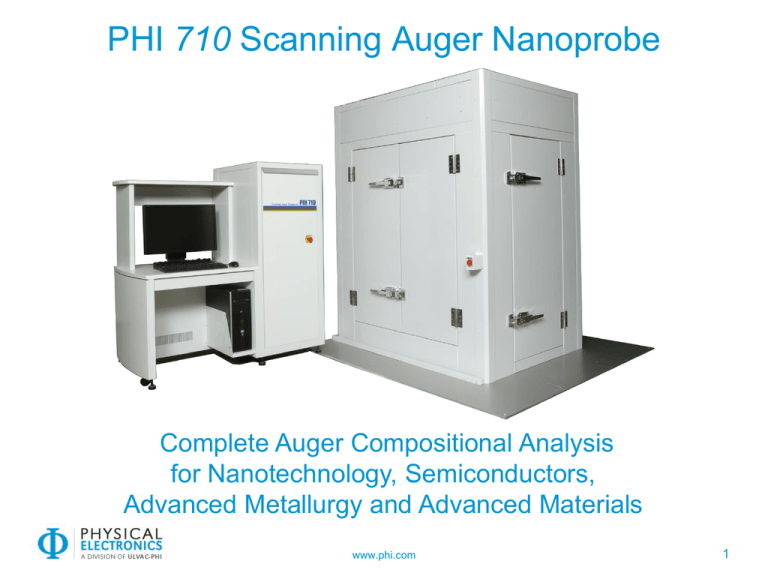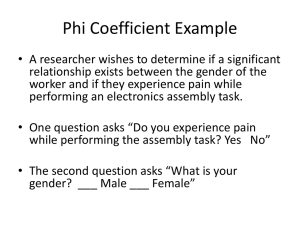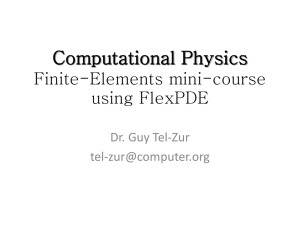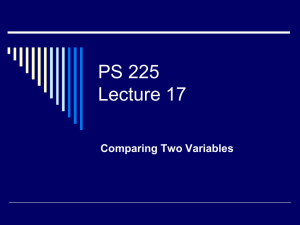Compucentric Zalar rotation depth profiling
advertisement

PHI 710 Scanning Auger Nanoprobe Complete Auger Compositional Analysis for Nanotechnology, Semiconductors, Advanced Metallurgy and Advanced Materials www.phi.com 1 PHI Auger 710 Superior Analytical Capabilities Nanoscale image resolution Image registration for high sensitivity Constant sensitivity for all sample geometries High sensitivity at low tilt angles for insulator analysis Nano-volume depth profiling Chemical state analysis: spectra, imaging, depth profiling www.phi.com 2 PHI 710 Secondary Electron Imaging (SEI) 3 nm from Au Islands on Carbon www.phi.com 3 PHI 710: High Spatial Resolution Auger BAM-L200 Standard Sample AlGaAs Line Width (nm) Locations for Line Scans Area Analyzed 4 nm Al Line 1 2 Auger Line Scans 3 4 Ga Map 25kV; 1nA 256x256 pixels Line Analysis Al Map 25kV; 1nA 256x256 pixels 24 Hour stability test demonstrating exceptional image registry Sample provided by Federal Institute for Materials Research and Testing (BAM) Berlin, Germany www.phi.com Line Analysis PHI 710: High Spatial Resolution Auger BAM-L200 Standard Sample Line Scan #4 Intensity Ga Al (X3) 4 nm Line 0 0.05 0.1 0.15 0.2 Distance (µm) 0.25 0.3 0.35 24 hour analysis demonstrating exceptional image registration www.phi.com 5 Constant Sensitivity for All Geometries Minimum Beam Diameter 2,000 1,800 1,600 Sensitivity (kcps) MultiChannel Detector Sensitivity vs. Sample Tilt Field Emission Electron Source Cylindrical Mirror Analyzer 1,400 1,200 1,000 800 Coaxial CMA 600 400 Non-Coaxial SCA 200 0 -90 -75 -60 -45 -30 -15 0 15 30 45 60 75 90 Tilt Angle (degree) Ar+ Ion Gun Sample holder with high energy resolution optics www.phi.com The CMA with a coaxial electron gun provides high sensitivity at all sample tilt angles which is essential for insulator analysis 6 CMA with Coaxial Electron Gun Only the PHI 710 can image samples such as FIB sections with uniform, high sensitivity Poly-Si/W Deposition and Patterning Auger Analysis of ex situ FIB cut Auger maps show: Defect is sub-micron Si oxide particle Surrounded by elemental Si Introduced during poly-Si deposition Covered with W Auger Maps: Si oxide Si elemental W www.phi.com 7 PHI CMA High Energy Resolution Mode How does the high energy resolution mode work? – The CMA energy resolution is given as: – ΔE / E = 0.5% – An optics element placed between the sample surface and the entrance to the standard CMA retards the Auger electrons, reducing their energy, E – From the energy resolution equation, if E is reduced, ΔE is also reduced and so is the Auger peak width; energy resolution is improved – The CMA is not modified in any way and retains a 360º coaxial view of the sample relative to the axis of the electron gun – US Patent 12 / 705,261 www.phi.com 8 PHI CMA High Energy Resolution Mode 710 Energy Resolution Specification 0.6 ΔE / E (%) 0.5 0.4 0.3 0.2 0.1 0.0 0 500 1000 1500 2000 2500 Auger Peak Kinetic Energy (eV) www.phi.com 9 PHI CMA High Energy Resolution Mode Al KLL Spectra of Native Oxide on Al Foil 350 0.5% 0.1% 300 250 N(E) cps 200 150 100 50 0 1386.9 eV (Al oxide) -50 1350 1360 1370 1393.4 (Al metal) 1380 1390 Kinetic Energy (eV) 1400 1410 1420 Auger KLL spectrum of native oxide on Al foil measured on PHI CMA at 0.5% (blue) and 0.1% (red) energy resolution, after background subtraction. www.phi.com 10 PHI CMA High Energy Resolution Mode Zn LMM Spectra of Sputter Cleaned Zn Metal 1 0.5% Energy Resolution 0.1% Energy Resolution 0.9 0.8 Normalized Intensity 0.7 0.6 0.5 0.4 0.3 0.2 0.1 0 970 980 990 1000 1010 Kinetic Energy (eV) www.phi.com 1020 1030 11 PHI CMA High Energy Resolution Mode Depth Profile of Native Oxide on Si 4 0.1% Energy Resolution x 10 Si elemental 8 6 Si oxide c/s 4 Si plasmons 2 0 10 kV - 10 nA 20 µm defocused beam 4 minutes per cycle -2 60 40 20 0 1580 1590 1600 1610 1620 1630 Kinetic Energy (eV) www.phi.com 12 PHI CMA High Energy Resolution Mode Depth Profile of Zn Oxide on Zn Zn oxide Zn metal 5 x 10 9.8 9.6 9.4 c/s 9.2 9 10 8.8 5 8.6 8.4 0 970 980 990 1000 1010 Kinetic Energy (eV) www.phi.com 1020 1030 13 PHI 710 Spectral Window Imaging IC.401.sem: Pad 41 IC412_256.map: PHI Pad 41 PHI Pad 41 IC412_256.map: 2012 Sep 21 10.0 kV 10 nA FRR 2012 Sep 22 10.0 kV 10 nA FRR 2012 Sep0.00 22 s10.0 kV 10 nA FRR Si4/-1RSF Si4/-1RSF SEM/-1 SEI SEM B 4094 Si KLL Peak Area Si4 RSF Silicide Si4.ls1 C 3462175 IC412_256.map: 20 Padµm 41 892.8 PHI Pad 41 IC412_256.map: 2012 Sep 22 10.0 kV 10 nA FRR 2012 Sep 22s 10.0 kV 10 nA FRR 0.00 IC412_256.map: 1137329 PHI Pad 41 20 µm 0.00 2012 Sep 22 s 10.0 kV 10 nA FRR Si4/-1 Si4/-1 RSF Si4/-1RSF 20 µm Elemental Si Si4.ls2 Si Oxynitride Si4.ls3 E 32297 20 µm 7465 F 32297 7465 PHI 0.00 s RSF Si Chemical States Si4.ls1+Si4.ls2+Si4.ls3 47.0 20 µm 20 µm 20 µm D 32297 20 µm 20 µm 20 µm A PHI 0.00 s 7465 20 µm 20 µm 0.0 Panel A shows a 200 µm FOV SEI of a semiconductor bond pad. Panel B shows the Si KLL peak area image from the area of panel A. Panels C, D and E show the chemical state images of silicide, elemental Si and Si oxynitride respectively. Panel F shows a color overlay of elemental silicon, silicide and silicon oxynitride images. www.phi.com 14 PHI 710 Spectral Window Imaging IC412_256.map: Pad 41 PHI 2012 Sep 22 10.0 kV 10 nA FRR Si4/-1 Composite Si KLL A 0.00 s with ROI areas B Si KLL image Si4 RSF 20 µm 1605 1615 1625 Kinetic Energy (eV) 1137329 20 µm C Si KLL Basis Spectra Si Oxynitride Silicide Intensity Panel A shows the Si KLL spectrum from the sum of all pixel spectra in the Si KLL Auger image shown in panel B. Panel B shows the three Regions Of Interest (ROI) selected for creation of the basis spectra for Linear Least Squares (LLS) fitting of the Si KLL image data set. Panel C shows the three basis spectra with their corresponding chemical state identifications. Intensity 3462175 Elemental Si PHI App. Note: Chemical State Imaging With The PHI 710 Scanning Auger NanoProbe 1604 1608 www.phi.com 1612 1616 Kinetic Energy (eV) 1620 1624 15 Nanocone Imaging Auger Images Suggest Larger Nanocone Surface Composed of Silicon Oxide and Nitride Smaller Silicon Oxide Feature Smaller Silicon Oxide Feature 2O kV – 10 nA SEI N Map 256 x 256 pixels HR Si-oxide Map at 0.1% Energy Resolution Only the larger Nanocone contains N Both the large and small features contain Silicon oxide The composition suggested by the images is confirmed with high energy resolution analysis www.phi.com 16 Nanocone Chemical Analysis Large Nanocone Base 0.1% Energy Resolution Si Oxide Standard Si Nitride Standard 1 Si KLL Normalized Intensity 0.8 0.6 0.4 0.2 20 kV – 10 nA 0 1600 1605 1610 1615 1620 Kinetic Energy (eV) 1625 1630 Nanocone base is mixture of silicon oxide and silicon nitride www.phi.com 17 PHI 710 Advantages World’s best Auger depth profiling – Floating column ion gun for high current, low voltage depth profiling – Compucentric Zalar Rotation™ maximizes depth resolution – Image registration maintains field-of-view www.phi.com 18 Low Voltage Depth Profiling Improved Interface Definition with use of Ultra Low Ion Energies 500 eV Depth Profile 100 eV Depth Profile Al Intensity Intensity Al 0 Ga Ga As As 0 10 20 30 Sputter Time (min) 200 400 600 Sputter Time (min) 800 Improved definition of layers AlAs/GaAs Super Lattice Sample www.phi.com 19 Nano Depth Profiling 60 nm Diameter Si Nanowire 4 1 Surface Spectrum of Nanowire A x 10 Atomic % Si 97.5 P 2.5 SEI 0.5 0 P c/s 1 -0.5 O -1 20 kV, 10 nA, 13 nm Beam FOV: 2.0 µm F 0.5 µm -1.5 C Si -2 100 200 300 400 500 600 Kinetic Energy (eV) 700 800 P from the growth gas is detected on the surface of a Si nanowire www.phi.com 20 Non-homogeneous P Doping of Si Nanowires Depth Profile of Nanowire B 500 V Ar sputter depth profiling shows a non-homogeneous radial P distribution. The data suggests Vapor-Solid incorporation of P rather than Vapor-Liquid-Solid P incorporation www.phi.com 21 Compucentric Zalar Rotation Depth Profiling Ion Beam Compucentric Zalar rotation depth profiling defines the selected analysis point as the center of rotation. This is accomplished by moving the sample in X and Y while rotating, all under software control. Analysis Area Micro-area Zalar depth profiling is possible on features as small as 10 µm with the 710’s automated sample stage. Sample Zalar rotation is used to eliminate sample roughening that can occur when sputtering at a fixed angle. www.phi.com 22 Compucentric Zalar Rotation Depth Profiling Compucentric Zalar Depth Profile of 10 µm Via Contact 100 Atomic Concentration (%) Al (metal) Si 80 O 60 40 Al (oxide) 20 Secondary Electron Image (Before Sputtering) 0 0 www.phi.com 50 100 150 200 250 Sputter Time (min) 300 23 Compucentric Zalar Rotation Depth Profiling Depth Profile Comparison With and Without Zalar Rotation 100 100 Al (metal) 80 Atomic Concentration (%) Atomic Concentration (%) Al (metal) Si O 60 40 Al (oxide) 0 80 O 60 40 Al (oxide) 20 20 0 Si 50 100 150 200 250 Sputter Time (min) 300 With Rotation 0 0 50 100 150 200 250 Sputter Time (min) 300 Without Rotation www.phi.com 24 Compucentric Zalar Rotation Depth Profiling SE Images of 10 µm Via Contacts after Depth Profiling 2500X 2500X With Rotation Without Rotation www.phi.com 25 Large Area Chemical Depth Profile of Ni/Si Wafer Annealed at 425 ºC Elemental Depth Profile 300 0.1% Energy Resolution 10 kV-10 nA 20 µm Average As Received Ni LMM Si KLL Sputter Conditions: 500 V Argon 1 x 0.5 mm raster 200 Intensity (kcps) No Zalar Rotation 10° Sample Tilt 100 Chemical State of Ni ? Chemical State of Si ? 0 0 10 20 30 Sputter Time (min) www.phi.com 40 50 60 26 Large Area Chemical Depth Profile of Ni/Si Wafer Annealed at 425 ºC Si Chemical Depth Profile Created Using Linear Least Squares Fitting Si KLL Intensity (kcps) 200 Si in Si substrate 100 Si in Ni layer 0 0 10 20 30 Sputter Time (min) www.phi.com 40 50 60 27 Large Area Chemical Depth Profile of Ni/Si Wafer Annealed at 425 ºC 0.1% Energy Resolution Si basis spectra for LLS (expanded) Si basis spectra for LLS Si KLL Si KLL Si in Si substrate Si in Ni layer Normalized Intensity 1570 Si in Ni layer Normalized Intensity Si in Si substrate 1590 1610 Kinetic Energy (eV) 1630 1610 1615 1620 Kinetic Energy (eV) 1616.5 eV (metal) www.phi.com 1625 1617.2 eV (silicide) 28 Large Area Chemical Depth Profile of Ni/Si Wafer Annealed at 425 ºC Si Chemical Depth Profile Created Using Linear Least Squares Fitting 300 0.1% Energy Resolution Intensity (kcps) Ni LMM Ni in Ni layer 200 Ni in Si substrate 100 0 0 10 20 30 Sputter Time (min) www.phi.com 40 50 60 29 Large Area Chemical Depth Profile of Ni/Si Wafer Annealed at 425 ºC 0.1% Energy Resolution Ni basis spectra for LLS Ni basis spectra for LLS (expanded) Ni LMM Ni LMM 810 820 830 Ni in Ni layer 840 850 860 Kinetic Energy (eV) Normalized Intensity Normalized Intensity Ni in Si substrate 870 830 880 Ni in Si substrate 835 840 845 850 Kinetic Energy (eV) 844.8 eV (Ni-silicide) www.phi.com Ni in Ni layer 855 860 846.2 eV (Ni-metal) 30 Large Area Chemical Depth Profile of Ni/Si Wafer Annealed at 425 ºC After Depth Profile 2 Intensity (Mcps) 2.5 1 Si Si 2.0 Ni 1.5 Ni Ni | | Si | | Point 1 Ni Point 2 C 1.0 FOV: 5.0 µm F SEM Fe3C 20kV - 1nA 20.000 keV 1.0 µm Si C 2/16/2010 22 nm beam size Analysis points 500 Auger multi-point analysis shows composition of nano-structures www.phi.com 1000 1500 Kinetic Energy (eV) 2000 Point 1: Ni-silicide Point 2: Si-metal 31 Large Area Chemical Depth Profile of Ni/Si Wafer Annealed at 425 ºC After Depth Profile 0.1% Energy Resolution Si KLL Point 2 Si in Si substrate Point 1 Si in Ni layer Point 2 Si in Si substrate Point 1 Si in Ni layer Normalized Intensity Normalized Intensity 22 nm beam size Si KLL (expanded) 22 nm beam size 1570 1580 1590 1600 1610 1620 Kinetic Energy (eV) 1630 1640 1610 1615 1620 Kinetic Energy (eV) 1616.5 eV (metal) www.phi.com 1625 1617.2 eV (silicide) 32 Ni/Si Annealed at 425 °C 12 nm Removed Nano-areas selected for depth profiling 2 2 1 FOV: 5.0 µm F SEM Ni/Si 425C 20 kV - 10 nA 20.000 keV 1 1.0 µm 3/30/2010 Analysis points Auger Color Overlay www.phi.com 20 kV - 10 nA 256 x 256 pixels 33 Nano Area Chemical Depth Profile of Ni/Si Wafer Point 1 – Ni Layer Chemical Depth Profile Created Using Linear Least Squares Fitting Ni metal Si metal Intensity (kcps) 200 Sputter Conditions: 500 V Argon 1 x 0.5 mm raster 10 kV – 10 nA Point 1 LLS Profile No Zalar Rotation 10° Sample Tilt 100 Si silicide Ni silicide 22 nm beam size 0 0 20 40 60 80 100 120 Sputter Depth (nm) 140 160 180 200 Nano area depth profile shows nickel silicide at the nickel / silicon interface Large area depth profile included heterogeneous distributions of nickel silicide that grows through imperfections in Ni film www.phi.com 34 PHI 710 Scanning Auger Nanoprobe Multi-technique Options Energy Dispersive Spectroscopy (EDS or EDX) Backscatter Electron Detector (BSE) Electron Backscatter Diffraction (EBSD) Focused Ion Beam (FIB) The Complete Auger Solution www.phi.com 35 PHI 710 Chamber Layout for Options www.phi.com 36 PHI 710 Scanning Auger Nanoprobe Complete Auger Compositional Analysis for Nanotechnology, Semiconductors, Advanced Metallurgy and Advanced Materials www.phi.com 37







